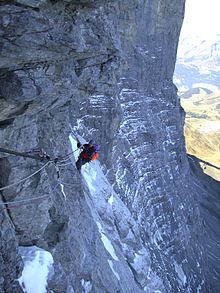
| Part of a series on |
| Climbing |
|---|
| Lists |
| Types of rock climbing |
| Types of mountaineering |
| Other types |
| Key actions |
| Key terms |
Alpine climbing (German: Alpinklettern) is a type of mountaineering that uses any of a broad range of advanced climbing skills, including rock climbing, ice climbing, and/or mixed climbing, to summit typically large routes (e.g. multi-pitch or big wall) in an alpine environment. While alpine climbing began in the European Alps, it is used to refer to climbing in any remote mountainous area, including in the Himalayas and Patagonia. The derived term alpine style refers to the fashion of alpine climbing to be in small lightly equipped teams who carry their equipment (e.g. no porters), and do all of the climbing (e.g. no sherpas or reserve teams).
Alpinists face a wide range of serious risks in addition to the specific risks of rock, ice, and mixed climbing. This includes the risks of rockfalls (common with rock faces in alpine environments), avalanches (especially in couloirs), seracs and crevasses, violent storms hitting climbers on exposed mountain faces, altitude effects (dehydration, edema, frostbite), complex navigation and route finding, long abseils, and the difficulty of rescue and/or retreat due to the remote setting. Due to the scale of the routes, alpine climbers need to be able to move together for speed (e.g. simul climbing or as rope teams), which is another source of specific risk.
The first "golden age" of modern alpine climbing was the first free ascents–in summer, in winter, and as solo–of the great north faces of the Alps by pioneers such as Walter Bonatti, Riccardo Cassin and Gaston Rebuffat. The subsequent era, which is still ongoing, is focused on the equivalent ascents and enchainments, of the ice and snow-covered faces and ridges of major Himalayan peaks (e.g. the eight-thousanders, Latok, The Ogre) and Patagonian peaks (e.g. Cerro Torre Group, Fitz Roy Group) in "alpine style" by pioneers such as Hermann Buhl, Reinhold Messner and Doug Scott, and latterly by alpinists such as Ueli Steck, Mick Fowler, Paul Ramsden, and Marko Prezelj. The annual Piolets d'Or are awarded for the best achievements in alpine climbing.
- ^ "Eiger speed record by Dani Arnold". PlanetMountain. 24 April 2011. Retrieved 10 May 2023.
